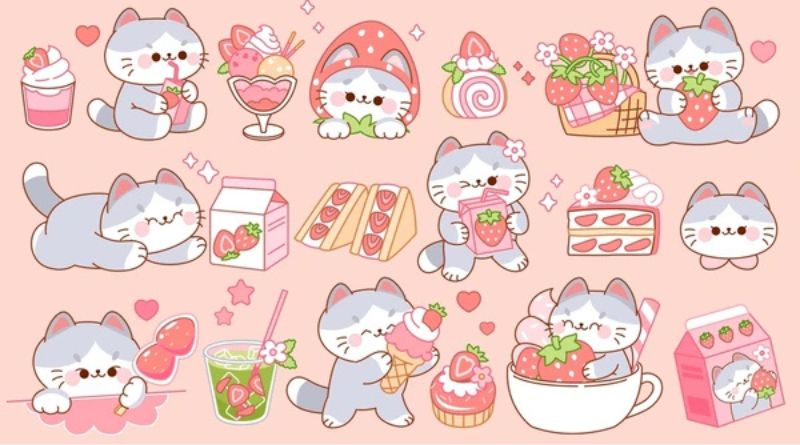
When you hear the term “Kawaii”, chances are it conjures images of adorable, irresistibly cute characters, often characterized by oversized eyes, small features, and an overall charming aesthetic. The word “kawaii” (かわいい) translates to “cute” or “lovable” in Japanese and has become a hallmark of Japanese pop culture, influencing everything from fashion and art to animation and social media. Among the most iconic and beloved symbols in the world of kawaii culture is the kawaii cat.
In this article, we’ll explore what makes a kawaii cat so universally adored, delve into its significance in Japanese culture, and discuss how it’s manifested in various forms, from cartoons to fashion and even internet memes. We’ll also touch on the potential connection to the phrase kawaii:i3hloh_c1zu=, which seems like a coded reference, possibly pointing to specific digital expressions or representations of the cute cat phenomenon.
Table of Contents
What Makes a Cat “Kawaii”?
To understand the phenomenon of the kawaii cat, we first need to examine what makes a character or creature “kawaii” in the first place. The kawaii aesthetic is all about innocence, cuteness, and playfulness. It’s about creating things that evoke a sense of tenderness and affection. In the case of a kawaii cat, several design elements contribute to making the cat more lovable and “cute”:
- Big Eyes: One of the most prominent features of kawaii characters, including cats, is their oversized, expressive eyes. This design choice mimics the appearance of babies and young animals, which are universally perceived as more adorable. Big eyes convey innocence and vulnerability, making the cat appear approachable and endearing.
- Small Size: Kawaii cats are often depicted as small and compact, enhancing their cuteness. Their diminutive size adds to the feeling of fragility, making them seem like something we want to protect and care for.
- Simplified Features: Kawaii cats usually have minimalistic, soft features. Their faces are often devoid of sharp lines or complex details. Their tiny, simple noses and mouths create a soft, gentle appearance that adds to their charm.
- Exaggerated Expressions: To convey emotions like joy, surprise, or sadness, kawaii cats often feature exaggerated facial expressions. Whether it’s a wide, happy grin or a small, shy smile, these expressions are designed to evoke a sense of empathy and affection from viewers.
- Playful and Innocent Behavior: A key element of kawaii culture is innocence and purity, and kawaii cats are no exception. These cats are often depicted engaging in innocent, cute activities like playing with yarn, curling up for naps, or even interacting with other adorable animals or characters.
The Rise of Kawaii Cats in Japanese Pop Culture
The concept of kawaii has permeated almost every aspect of Japanese society, and cats, as one of the most popular animals in Japan, have been a natural fit for this aesthetic. The kawaii cat has a long history in Japanese culture, but it really gained worldwide recognition through pop culture phenomena like Hello Kitty.
1. Hello Kitty: The Iconic Kawaii Cat
Perhaps the most famous kawaii cat of all is Hello Kitty. Created by Sanrio in 1974, Hello Kitty has become a global symbol of cuteness and has transcended the world of children’s toys into fashion, stationery, and even pop culture. With her simple face, lack of a mouth, and red bow, Hello Kitty has become an enduring emblem of kawaii culture.
Despite her immense popularity, Hello Kitty’s design is quite minimalistic—her face is a blank canvas, allowing anyone to project their own feelings onto her. This simplicity has contributed to her universal appeal, as Hello Kitty is not confined by age, gender, or nationality. She is a timeless, adorable character that embodies the essence of kawaii.
2. Maneki-neko: The Lucky Cat
Another important cat in Japanese culture is the maneki-neko, or “beckoning cat.” This cat figurine, often seen with one paw raised in a welcoming gesture, is believed to bring good luck, prosperity, and protection. While the maneki-neko is not traditionally “kawaii” in the sense of the modern aesthetic, its chubby, round form and friendly gesture have contributed to its appeal in kawaii culture. In recent years, the maneki-neko has been reimagined in more playful and colorful ways, aligning it more with the kawaii style.
3. Neko (Cat) in Japanese Animation and Manga
Cats also play a prominent role in Japanese anime and manga. Characters like Jiji from Kiki’s Delivery Service, Doraemon (a robotic cat), and Chi from Chi’s Sweet Home are all beloved figures in Japanese media. These cats are often depicted as kind, loyal, and humorous, embodying the playful and affectionate spirit of kawaii.
In manga, cats are frequently used to represent innocence and charm. They may be portrayed as companions, quirky sidekicks, or even magical beings. Their playful antics and endearing personalities make them relatable and lovable to viewers of all ages.
The Evolution of the Kawaii Cat in Digital Culture
In today’s digital age, the concept of the kawaii cat has found a new home on the internet, where it has become a symbol of positivity, fun, and lightheartedness. Platforms like Instagram, TikTok, and Twitter have seen an explosion of cute cat content, from real-life kittens to digital artwork and memes. These cats have become part of a global internet culture that shares joy and humor through simple, endearing imagery.
1. Cat Memes and Internet Culture
The internet is filled with countless cat memes, many of which are intentionally designed to be cute or funny. The rise of cats like Grumpy Cat, Nyan Cat, and Lil Bub has further entrenched the cat as a central figure in internet humor. These cats are often exaggerated for comedic effect, but their fundamental cuteness is what draws people in.
The success of cat memes is partially due to the widespread appeal of cats in general—cats are easy to anthropomorphize, and their quirky, independent personalities make them the perfect subject for funny and cute content. The kawaii cat in meme form continues to be a favorite for social media users around the world.
2. Digital Kawaii Cats in Art and Games
The kawaii cat has also made its way into the world of digital art and video games. Games like Neko Atsume (where players collect cute cats in various poses and outfits) and Cat Quest (an adventure game starring a cat hero) have become popular examples of how the kawaii aesthetic and the cat have merged into interactive entertainment.
Artists and creators on platforms like DeviantArt and Pixiv produce digital illustrations of kawaii cats, often inspired by traditional Japanese animation or the latest trends in character design. These cute, stylized cats are shared widely, allowing them to become icons in their own right.
The Connection to “kawaii:i3hloh_c1zu=”
The phrase “kawaii:i3hloh_c1zu=” might appear to be a code or reference to a specific digital art collection or unique identifier associated with a kawaii cat or a series of kawaii-themed digital works. It could be part of an art project, social media tag, or even a digital asset in a larger creative ecosystem. In the world of digital art and fandoms, unique strings like this are often used to organize and identify specific content, whether that’s for online exhibitions, collections, or community-based projects.
Conclusion: The Everlasting Appeal of Kawaii Cats
From their roots in traditional Japanese culture to their dominance in modern digital culture, kawaii cats have captured the hearts of people worldwide. Whether it’s through the timeless charm of Hello Kitty, the mischievous antics of animated cats, or the viral success of cat memes, these cute creatures have become a beloved symbol of innocence, joy, and lighthearted fun.
The kawaii cat continues to evolve, with new forms of digital art, media, and internet culture constantly reimagining these adorable animals in innovative ways. Their appeal is timeless, bridging cultures, ages, and platforms, making the kawaii cat a global icon of cuteness. Whether you’re a cat lover or simply someone who appreciates the aesthetic of “cute,” it’s clear that kawaii cats are here to stay.





